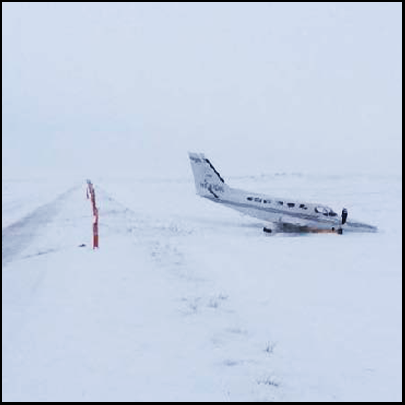-
What happened?
A small aircraft left the runway during an attempted take-off with a 13-20 mph tailwind.
At approximately 40mph, the captain aborted the take-off for undetermined reasons.
The aircraft stopped approximately 330metres / 1100feet from the start of the runway in deep snow.
Two passengers were treated for minor injuries at a nearby medical clinic and released.

-
Why did it happen?
Crew opted to take off with a tailwind, which increased operational risk
Captain applied full braking and full reverse thrust, causing a yawing moment and loss of directional control - even though there was enough remaining runway to stop safely.
The aircraft did not have anti-lock brakes.
The aviation service provider does not train pilots to apply different techniques for high‐speed and low-speed take-off aborts on varying runway surface conditions.

-
What did they learn?
Clearly define the conditions when a tailwind take-off can be accomplished.
Provide initial and recurring training on high/low speed abort procedures.
Improve the formal on-boarding process for aviation service providers.

-
Ask yourself or your crew
How could something like this happen in our aviation operations?
How clear are our conditions for safe aircraft take-offs in tailwinds?
How well do we train aviation crews for take-off abort procedures?
How effective is the on-boarding process for aviation service providers?

Add to homescreen
Content name
Select existing category:
Content name
New collection
Edit collection
What happened?
A small aircraft left the runway during an attempted take-off with a 13-20 mph tailwind.
At approximately 40mph, the captain aborted the take-off for undetermined reasons.
The aircraft stopped approximately 330metres / 1100feet from the start of the runway in deep snow.
Two passengers were treated for minor injuries at a nearby medical clinic and released.

Why did it happen?
Crew opted to take off with a tailwind, which increased operational risk
Captain applied full braking and full reverse thrust, causing a yawing moment and loss of directional control - even though there was enough remaining runway to stop safely.
The aircraft did not have anti-lock brakes.
The aviation service provider does not train pilots to apply different techniques for high‐speed and low-speed take-off aborts on varying runway surface conditions.
What did they learn?
Clearly define the conditions when a tailwind take-off can be accomplished.
Provide initial and recurring training on high/low speed abort procedures.
Improve the formal on-boarding process for aviation service providers.
Ask yourself or your crew
How could something like this happen in our aviation operations?
How clear are our conditions for safe aircraft take-offs in tailwinds?
How well do we train aviation crews for take-off abort procedures?
How effective is the on-boarding process for aviation service providers?
A small aircraft left the runway during an attempted take-off, stopping in the snow. Two passengers received minor injuries.












